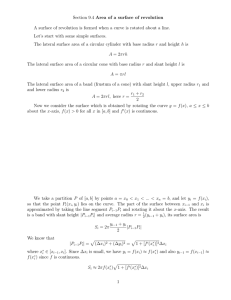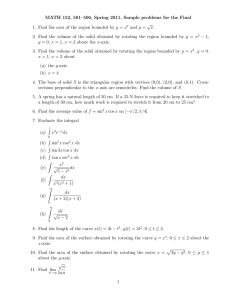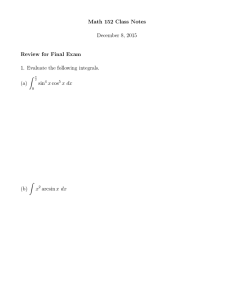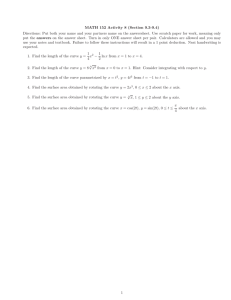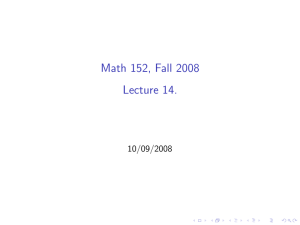Section 9.4 Area of a surface of revolution
advertisement
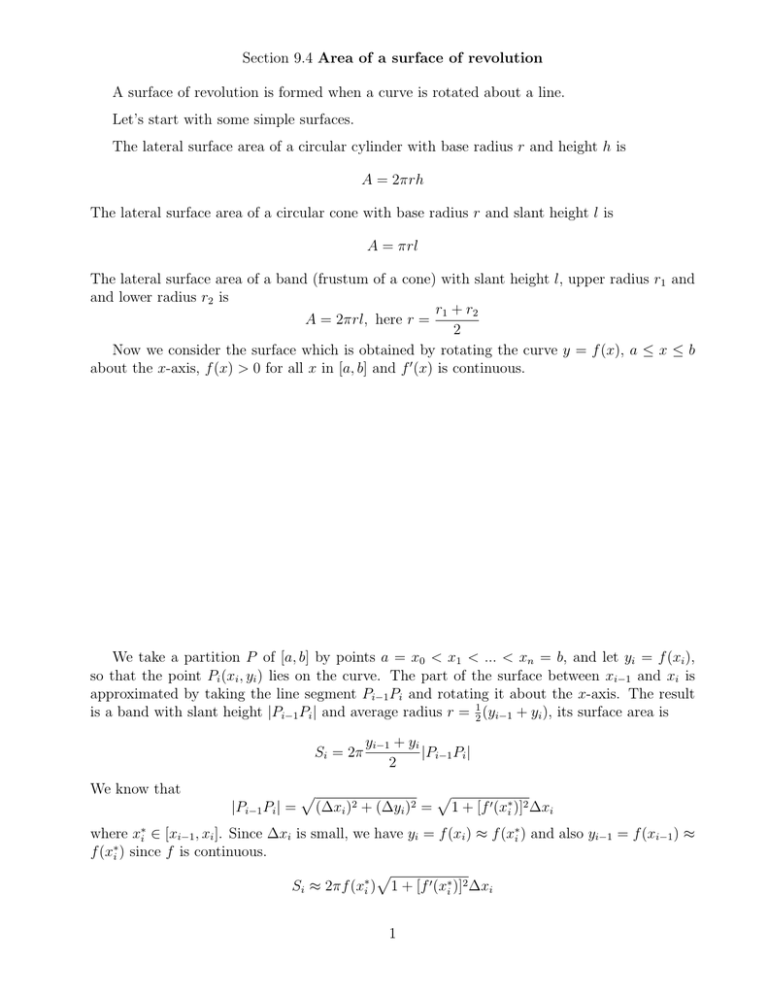
Section 9.4 Area of a surface of revolution A surface of revolution is formed when a curve is rotated about a line. Let’s start with some simple surfaces. The lateral surface area of a circular cylinder with base radius r and height h is A = 2πrh The lateral surface area of a circular cone with base radius r and slant height l is A = πrl The lateral surface area of a band (frustum of a cone) with slant height l, upper radius r1 and and lower radius r2 is r1 + r2 A = 2πrl, here r = 2 Now we consider the surface which is obtained by rotating the curve y = f (x), a ≤ x ≤ b about the x-axis, f (x) > 0 for all x in [a, b] and f 0 (x) is continuous. We take a partition P of [a, b] by points a = x0 < x1 < ... < xn = b, and let yi = f (xi ), so that the point Pi (xi , yi ) lies on the curve. The part of the surface between xi−1 and xi is approximated by taking the line segment Pi−1 Pi and rotating it about the x-axis. The result is a band with slant height |Pi−1 Pi | and average radius r = 12 (yi−1 + yi ), its surface area is Si = 2π yi−1 + yi |Pi−1 Pi | 2 We know that |Pi−1 Pi | = p p (∆xi )2 + (∆yi )2 = 1 + [f 0 (x∗i )]2 ∆xi where x∗i ∈ [xi−1 , xi ]. Since ∆xi is small, we have yi = f (xi ) ≈ f (x∗i ) and also yi−1 = f (xi−1 ) ≈ f (x∗i ) since f is continuous. p Si ≈ 2πf (x∗i ) 1 + [f 0 (x∗i )]2 ∆xi 1 Thus, the area of the complete surface is n X SX = 2π lim kP k→0 Z 2π b p f (x∗i ) 1 + [f 0 (x∗i )]2 ∆xi = i=1 Z b p 0 2 f (x) 1 + [f (x)] dx = 2π f (x) a s dy 1+ dx a 2 dx If the curve is described as x = g(y), c ≤ y ≤ d, then the formula for the surface area is s 2 Z d p Z d dx 0 2 SX = 2π y 1 + [g (y)] dy = 2π y 1+ dy dy c c Let’s a curve C is defined by the equations x = x(t), a≤t≤b y = y(t), The area of the surface generated by rotating C about x-axis is Zb SX = 2π s y(t) dx dt 2 dy + dt 2 dt a For rotation about the y-axis, the surface area formulas are: if the curve is given as y = f (x), a ≤ x ≤ b, then the formula for the surface area is Zb SY = 2π s dy x 1+ dx 2 dx a if the curve is described as x = g(y), c ≤ y ≤ d, then the formula for the surface area is s 2 Z d dx SY = 2π g(y) 1 + dy dy c If a curve C is defined by the equations x = x(t), a≤t≤b y = y(t), then the area of the surface generated by rotating C about y-axis is Zb SY = 2π s x(t) a 2 dx dt 2 dy + dt 2 dt Example 1. Find the area of the surface obtained by rotating the curve about x-axis √ (a) y = x, 4 ≤ x ≤ 9 (b) y 2 = 4x + 4, 0 ≤ x ≤ 8 (c) x(t) = a cos3 t, y(t) = a sin3 t, 0 ≤ t ≤ π/2, a is a constant. 3 For rotation about the y-axis, the surface area formulas are: if the curve is given as y = f (x), a ≤ x ≤ b, then the formula for the surface area is Zb SY = 2π s df x 1+ dx 2 dx a if the curve is described as x = g(y), c ≤ y ≤ d, then the formula for the surface area is s 2 Z d dg SY = 2π g(y) 1 + dy dy c if the is defined by the equations x = x(t),y = y(t), a ≤ t ≤ b, then the area of the surface is Zb SY = s 2 2 dx dy x(t) + dt dt dt a Example 2. Find the area of the surface obtained by rotating the curve about y-axis p (a) x = 2y − y 2 , 0 ≤ y ≤ 1 (b) y = 1 − x2 , 0 ≤ x ≤ 1 4 (c) x = et − t, y = 4et/2 , 0 ≤ t ≤ 1 5
